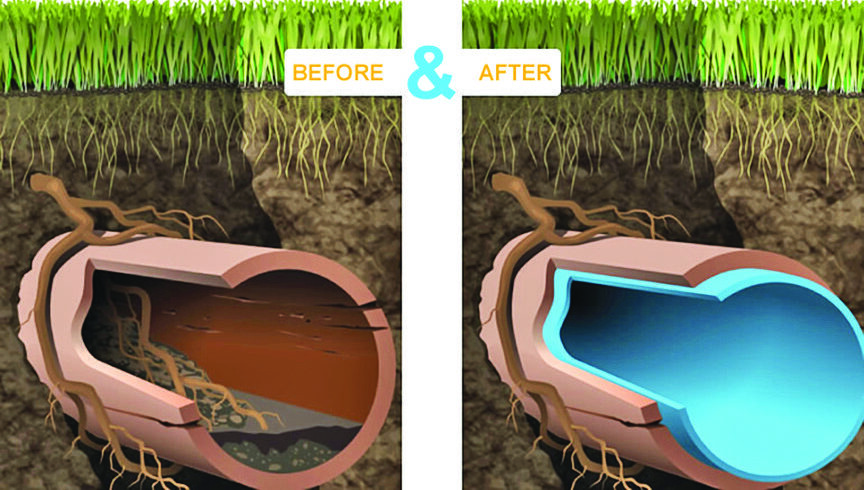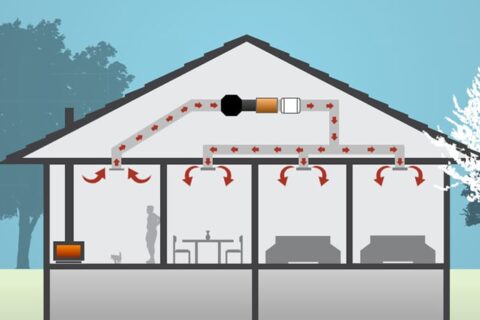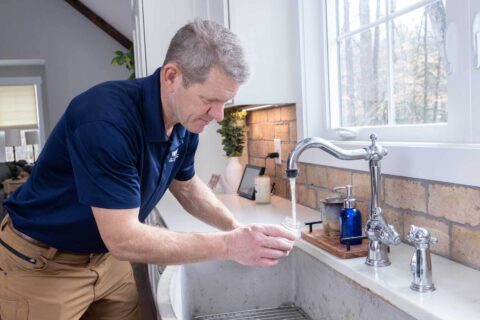Trenchless Sewer Line Replacement Methods Explained
Key Takeaways
-
Trenchless sewer line replacement is the best, most modern, and least invasive option. It protects your landscaping and greatly minimizes property destruction by staying away from major excavation.
-
Not only are trenchless techniques less invasive, they’re much less expensive, saving time and money over traditional methods. They save in project duration, labor hours and restoration.
-
Several methods, such as pipe bursting, pipe lining, and directional drilling, provide tailored solutions for different pipe conditions and damage levels.
-
With advanced technology and materials, such as resin liners and HDPE pipes, durability is guaranteed, with many repairs lasting over 50 years.
-
While trenchless methods are often a larger up-front expenditure, they go a long way toward providing long-term savings on maintenance and restoration, making them a wise, fiscally prudent investment.
-
Proper assessment of soil conditions, pipe damage, and property layout is essential to determine the most suitable trenchless method for your needs.
Trenchless sewer line replacement methods provide an effective, efficient and less disruptive means to fix aging, underground pipes. Unlike conventional digging, these technologies reduce harm to businesses and homes by allowing contractors to renovate or install new pipes with much less digging.
Methods like pipe bursting and cured-in-place pipe (CIPP) lining use advanced equipment to install or rehabilitate sewer lines directly through existing pathways. This method is much quicker, less expensive and protects existing landscaping or driveways.
Trenchless solutions are particularly useful in urban settings where space is tight and disruptions to the daily routine must be minimized. With an emphasis on precision and durability, these methods offer long-term reliability, all while fulfilling the needs of a modern infrastructure.
By exploring these options, you’re guaranteed a more practical, more effective, and more environmentally friendly approach to sewer line maintenance.
What Is Trenchless Sewer Line Replacement
Definition of Trenchless Sewer Replacement
Trenchless sewer replacement is a relatively new repair method that removes the need for extensive excavation. Rather than tearing up large portions of the lawn or pavement, trenchless technologies utilize a combination of lateral pipe bursting and relining materials to replace or restore buried pipelines.
This process usually employs trenchless technology, which includes pipe liners and resins. These materials are fed into the existing pipe to form a new, tough liner or interior. Additionally, the new liner will last 40-50 years, providing a long-term solution.
This approach is focused on fixing the sewer system at a reasonable cost. At the same time, it saves landscaping, sidewalks, and driveways from needless destruction.
How Trenchless Methods Differ from Traditional Methods
In contrast with conventional sewer replacements, trenchless repairs sidestep the burdens of digging big trenches. This greatly minimizes the damage to landscaping, decks, or driveways.
Repair is done in one or two days as opposed to weeks using traditional techniques. For instance, pipe lining can repair an entire sewer line in less than a day with only a few access points.
Not only are these methods less invasive, they can be more economical, saving taxpayers up to 50% on project costs. Since trenchless repairs alleviate the need for excessive physical labor and subsequent restoration, time and money are saved on both ends of the process.
Common Trenchless Sewer Line Replacement Methods
Trenchless sewer line replacement provides creative options for replacing damaged sewer lines with less hassle and inconvenience. With an approach that’s customized to each specific damage, these methods deliver proven, effective, long-lasting results. Choosing the best method for replacement will vary based on the condition of the sewer line, since every technique has distinct advantages.
Developments in trenchless technology have made these techniques faster, more accurate and safer than ever before. In the process, they have become more affordable and predictable.
1. Pipe Bursting Method
Pipe bursting is a trenchless sewer repair method that involves breaking the existing pipe while simultaneously replacing it with a new one. A pulling head breaks the old pipe as it drags a new high-density polyethylene (HDPE) pipe into the old pipe’s place. This trenchless option only requires a minor entry and exit pit, making it ideal for flat, horizontal sewer lines.
The entire trenchless sewer line replacement process is completed quickly—usually within one to two days. As a result, you end up with a strong, resilient system that can last upwards of half a century. In a residential setting, this technique minimizes disruption while addressing plumbing problems, such as replacing an aging or damaged 4-inch sewer line.
It effortlessly passes below an active driveway without needing to disrupt the concrete.
2. Pipe Lining Method
The pipe lining method, particularly the type known as cured-in-place pipe (CIPP) lining, consists of inserting a resin-coated liner into the damaged pipe. Once in place, the liner is cured, creating a strong, seamless new pipe within the old one. This technique needs extensive inspection and cleaning for the new liner to bond correctly.
It’s best suited for sealing cracks or leaks in current pipes from the inside out with no digging required. A home with a degraded 6” sewer line can get up and running in no time. All of that in as little as a few days if they use CIPP!
3. Horizontal Directional Drilling Method
Horizontal directional drilling (HDD) is another trenchless method used to install new pipes underground with high precision and low surface disruption. This is a highly effective trenchless technique for crossings under challenges such as roads, sidewalks, or landscaped areas.
HDD is adaptable, operating efficiently in differing soil types and working for both residential and commercial projects. For instance, yes, a company can replace a 12-inch sewer line underneath a congested street by going this route.
This allows them to continue business as usual, even under the need for a lot of digging.
4. Spray-In-Place Pipe Lining Method
Spray-in-place pipe lining consists of spraying an epoxy or polymer coating directly into an existing pipe. This method is non-structural and is ideal for smaller diameter pipes, like those found in residential plumbing systems. The installation process is quite simple, and provides a fairly quick turnaround time with little to no disruption to your property.
A homeowner with a decrepit 3-inch pipe in their basement can replace it in a few hours. This method allows for fast, trenchless, and permanent repairs!
Advantages of Trenchless Sewer Line Replacement
Minimizes Property Damage
Trenchless sewer line replacement methods work to keep your property looking its best while performing essential repairs. Rather than tearing up entire yards to find the problem, these methods require minimal access points, preserving the integrity of your landscaping, driveways, and sidewalks.
They require traditional repairs that usually involve tearing up a large section of your lawn. They may involve the need to dig up paved surfaces—which can result in costly restoration projects.
In stark contrast, with trenchless methods, there’s virtually no digging required, so your yard and hardscaping remain completely undisturbed. You’ll save plenty on landscaping after the repair, thanks to this method.
It’s a less invasive process, so you’ll avoid the inconvenience of having your property torn up for months.
Reduces Project Completion Time
Perhaps the most notable advantage of trenchless sewer line replacement is its overall efficiency. Repairs that typically require weeks with conventional excavation can often be completed in as little as 24 to 72 hours.
That time frame doesn’t even include the curing time! This swiftness is especially advantageous for homeowners with immediate sewer line emergencies.
A typical trenchless pipe relining project takes only a few days to complete. Traditional repairs typically need massive excavation and cleanup efforts, which can increase the repair timeline dramatically.
The quicker resolution means there’s less disruption to daily life and homeowners can get back to normalcy without the added stress of prolonged delays.
Lowers Overall Labor Costs
Because of its limited digging needs, trenchless sewer line replacement requires fewer work hours. With traditional methods that require digging up the entire line, it takes a whole crew and a lot of machinery.
In comparison, trenchless methods use specialized equipment and smaller crews, reducing the cost of manual labor. The elimination of the cost of restoring affected property after the repair results in huge cost savings.
For homeowners who are cost-conscious, this cost-effective method offers a smart, responsible solution that doesn’t sacrifice quality.
Environmentally Friendly Process
Trenchless sewer line replacement is not just efficient. It’s environmentally conscious. By eliminating the need for a large-scale excavation, these techniques minimize the disturbance of soil and surrounding materials, minimizing the creation of waste materials.
It’s no secret that traditional repairs wreak havoc on local ecosystems. Trenchless techniques get the work done without disturbing nearby vegetation, waterways, or wildlife.
The sustainable benefits of trenchless repairs are significant. The long-lasting, corrosion-resistant materials used in trenchless repairs significantly increase sustainability.
They can increase the lifespan of sewer systems by up to 50 years. This long-term durability means less frequent re-repairs, saving both our resources and the environmental impact that comes with the remaking of infrastructure.
Disadvantages of Trenchless Sewer Line Replacement
Trenchless sewer line replacement deserves its reputation for being efficient and noninvasive, particularly when considering trenchless sewer repair methods. However, it’s important to know the potential drawbacks before making a leap of faith. These trenchless techniques, though amazing, aren’t without their complications, as soil conditions, pipe specifications, and costs can further complicate the trenchless sewer repairs process.
Higher upfront costs
Purchasing specialized tools and materials is a must for trenchless methods. Consequently, these methods typically incur greater up-front expenses than conventional trenching. Resins Cured-in-place pipe (CIPP) processes use CIPP epoxy resins that contain bisphenol A (BPA) and formaldehyde. Depending on the exact materials used, these can take multiple hours up to a day to fully cure.
The upfront cost can seem daunting at first. You will find major long-term savings from reduced labor and restoration costs, which more than offset it. For most, this trade-off is well worth the investment in order to skip potentially costly landscaping repairs. If you look only at the upfront cost, you won’t see the larger value. Taking this narrow view might keep you from identifying a more effective solution.
Limited suitability for certain soil types
Soil composition plays a crucial role in determining the feasibility of trenchless repairs. In rocky terrains or highly unstable soils, these methods might face significant challenges. Techniques like pipe bursting, which require pushing materials through the ground, often struggle in such conditions.
CIPP has specific pipe requirements, performing best on straight pipes between 1.5 to 6 inches in diameter and over 15 feet long. Pipes with multiple bends or diameters under 2 inches may not be ideal candidates, limiting the scope of this method. A thorough evaluation of the ground and pipe conditions is vital to ensure success.
Requires specialized equipment and expertise
It is essential to recognize that executing trenchless sewer line repair requires specialized equipment and trained professionals. Hydraulic machines and resin application systems are key tools in trenchless sewer repair methods to maximize effectiveness and efficiency. Misuse can lead to inefficient use or even damage that complicates sewer line issues.
For instance, entering the trenchless pipe lining process without the proper skill set can lead to disastrous effects, such as uneven curing of the epoxy. Hiring experienced, licensed plumbers who specialize in trenchless sewer repairs ensures the very best outcomes. This method significantly enhances the safety and lifespan of your plumbing system.
Opting for untrained professionals or teams without the right equipment only increases the chance of issues. This results in increased downtime and costs over time.
When to Choose Trenchless Sewer Line Replacement
Signs of Sewer Line Damage
Homeowners can avoid bigger headaches by catching the signs of sewer line damage early. Common indicators include:
-
This includes backup or clog in drains often a sign of blockage or damage in the sewer line.
-
Foul smells around sewer lines, which can indicate a leak or rupture.
-
Overly green patches or pooling water in the yard, indicating potential leaks below the ground.
-
Slow drainage in several fixtures, indicating a systemic problem instead of an isolated drain blockage.
If you’re experiencing any of these issues, it’s important to call a trusted plumber for a sewer camera inspection as soon as possible. A professional inspection provides accurate information, as one recent customer raved.
This level of clarity helps us to know exactly what the damage is and what steps need to be taken.

Suitability Based on Property Layout
The configuration of your property directly impacts whether or not trenchless methods will be a good fit. For properties with elaborate landscaping, mature tree canopies, or homes or buildings close to the street, the minimal disruption that trenchless techniques offer are a perfect fit.
Clear advantages are seen in urban settings, where space for excavation is more limited. Trenchless methods allow for convenience, needing only two small access points at each end of the pipe for roughly 50% of repairs.
They do all this without compromising on power.
Considerations for Long-Term Cost-Effectiveness
Trenchless sewer repair usually runs from $80 to $250 per foot upfront. It usually ends up saving you money over time.
With trenchless technology, durable materials are used, such as pipes made from PVC, clay, or cast iron, which can last 50 years or longer. This durability decreases the frequency of repairs, saving on maintenance expenses.
The speedy execution reduces disruption to everyday activities, providing both economic and convenience advantages.
Comparison Between Trenchless and Traditional Methods
Differences in Installation Process
Trenchless methods employ cutting-edge technologies like pipe lining and pipe bursting. These techniques greatly minimize the disruption caused by large-scale digging.
Pipe lining consists of inserting a flexible tube coated with resin into the damaged pipe. Once the resin is cured, it forms a strong new lining.
With pipe bursting, the old pipe is replaced by pulling a new one through. It very effectively breaks apart the existing pipe in the process.
These processes are quick, sometimes taking only hours or days to complete, minimizing the inconvenience of downtime for homes and businesses.
In contrast, traditional methods require workers to do a lot of digging to access the old pipe. This highly labor-intensive process often takes several days, even weeks, to accomplish. It comes down to how bad the pipe is damaged and how long of a stretch needs to be replaced.
Cost Comparison Over Time
In contrast, trenchless methods typically range in cost from $80 to $250 per foot of pipe. Though this seems steep, traditional methods average between $50 and $250 per foot as well.
In many instances, trenchless techniques are actually more economical in the long run. They take less labor hours and circumvent the extra costs of replacing or repairing landscaping or other infrastructure.
In fact, research maintains that trenchless techniques represent a more cost-effective alternative 80% of the time, particularly when it comes to complicated repairs.
Impact on Landscaping and Infrastructure
The most significant benefit of trenchless repair is the reduced impact on landscaping and infrastructure. These techniques preserve existing driveways, sidewalks and yards from unnecessary destruction.
Homeowners can save the cost and inconvenience of restoration. Traditional methods usually cause more than temporary inconvenience.
Excavating trenches results in damage to surrounding lawns, gardens and paved surfaces, often requiring costly restoration. This can make trenchless repairs especially attractive for properties with costly or well-established landscaping.
Comparison Table
|
Feature |
Trenchless Methods |
Traditional Methods |
|---|---|---|
|
Installation Time |
Hours to days |
Days to weeks |
|
Cost per Foot |
$80 to $250 |
$50 to $250 |
|
Landscaping Impact |
Minimal disruption |
Significant damage |
|
Techniques |
Pipe lining, pipe bursting |
Dig-and-replace |
|
Long-term Cost Efficiency |
Often more economical |
Higher restoration and labor costs |
Factors to Consider Before Choosing a Method
Assessing the Extent of Damage
Before deciding on a trenchless sewer line replacement method, the first step is understanding the condition of your existing pipe. A video inspection typically makes up the most important part of this process. We put a tiny camera down your sewer line to identify problems like cracks, corrosion, or clogs.
Trenchless technologies like pipe lining are ideal for repairing minor to moderate damage. When your pipe is peppered with small cracks or leaks, pipe lining allows you to insert a new, long-lasting layer within your existing pipe. This approach can add decades to a pipe’s useful life.
Bursting might be the right choice if the pipe is completely collapsed or irreparable. This method is another way to entirely replace the old pipe by breaking it apart and installing a new one at the same time. Both methods involve little to no excavation, often only one or two access points needed, keeping your yard or driveway intact.
Evaluating Soil and Ground Conditions
Soil type and ground stability are additional factors that affect the decision as to which trenchless method to use. Soft or loose soil is much easier to dig. Rocky or heavily compacted soil can make access difficult.
Trenchless technology is adaptable and effective for all pipe materials, including clay, PVC, or cast iron. Always consult professionals to make sure soil quality won’t jeopardize the process.
Consulting with Sewer Line Professionals
Being guided by seasoned professionals makes for a seamless and successful replacement. Doing some research on local companies and checking reviews on sites such as Yelp can help you find reputable providers.
In addition, many trenchless methods have their own long-term benefits built in, like corrosion-resistant materials and warranties of 50 years or more. Working with experienced experts will allow you to identify the best method to employ for your unique circumstances.
Conclusion
Trenchless sewer line replacement methods give communities a clever way to repair pipes. They use cutting edge technology to repair issues quickly and without the need for extensive digging in your yard. They save time, reduce disruption, and are often cheaper than traditional methods that involve digging up roadways. Using methods such as pipe bursting or cured-in-place pipe lining, you can target specific areas of concern and protect your green features.
Determining the best method to use involves consideration of the existing pipe’s condition, accessibility, and available budget. Whatever route you choose, it’s important to consider the advantages and disadvantages closely in order to select the best option for your house or property.
If you’re in need of sewer line replacement or repair, rely on trenchless sewer line replacement methods for an effective solution. Consult with a professional to discuss your options and determine which method is most appropriate for you.
Frequently Asked Questions
What is trenchless sewer line replacement?
Trenchless sewer line replacement is the latest technology for trenchless sewer repairs, allowing for the repair or replacement of sewer pipes with minimal digging and disruption. This innovative approach employs state-of-the-art trenchless sewer repair methods to repair or replace underground piping, preventing damage to landscaping, driveways, and other surfaces.
What are the most common trenchless sewer line replacement methods?
The two most prevalent trenchless sewer repair methods are pipe bursting and cured-in-place pipe (CIPP) lining. In the trenchless pipe bursting technique, the old pipe is broken apart to allow for a new pipe installation. In comparison, CIPP lining creates a new sewer pipe within the old using a resin liner.
How long does trenchless sewer line replacement take?
It’s worth noting that most trenchless sewer line repair methods can be completed in as little as 1–2 days, significantly faster than traditional sewer line replacement.
What are the advantages of trenchless sewer line replacement?
Even better, trenchless sewer repair methods are less invasive, faster, and more cost-efficient in the long run. They preserve landscaping, lower handling costs for labor and material, and cause significantly less disruption to your property than traditional sewer line replacement.
Are there any disadvantages to trenchless sewer line replacement?
Sure, trenchless sewer repair methods won’t be suitable for pipes that are completely collapsed or constructed from certain materials. They can be more costly upfront than traditional sewer line replacement methods too, depending on the circumstance.
When should I choose trenchless sewer line replacement?
Select trenchless sewer repair methods when you’re looking to do sewer line repairs with minimal excavation, save your landscaping, or make repairs as quickly as possible. This trenchless option is best suited for situations involving minor to moderate pipe damage or the relining of aging pipes.
How do trenchless methods compare to traditional sewer repair?
Trenchless sewer repair methods are not only less disruptive but also faster and more cost-effective. Unlike traditional sewer line replacement, which requires extensive excavation that can damage landscaping, trenchless options minimize disruption and reduce repair time.


